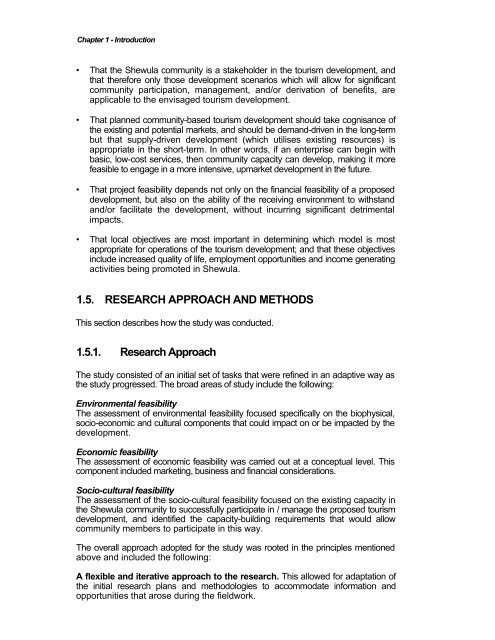Feasibility Study of Proposed Tourism Dev in Shewula, NE ...
Feasibility Study of Proposed Tourism Dev in Shewula, NE ...
Feasibility Study of Proposed Tourism Dev in Shewula, NE ...
You also want an ePaper? Increase the reach of your titles
YUMPU automatically turns print PDFs into web optimized ePapers that Google loves.
Chapter 1 - Introduction<br />
• That the <strong>Shewula</strong> community is a stakeholder <strong>in</strong> the tourism development, and<br />
that therefore only those development scenarios which will allow for significant<br />
community participation, management, and/or derivation <strong>of</strong> benefits, are<br />
applicable to the envisaged tourism development.<br />
• That planned community-based tourism development should take cognisance <strong>of</strong><br />
the exist<strong>in</strong>g and potential markets, and should be demand-driven <strong>in</strong> the long-term<br />
but that supply-driven development (which utilises exist<strong>in</strong>g resources) is<br />
appropriate <strong>in</strong> the short-term. In other words, if an enterprise can beg<strong>in</strong> with<br />
basic, low-cost services, then community capacity can develop, mak<strong>in</strong>g it more<br />
feasible to engage <strong>in</strong> a more <strong>in</strong>tensive, upmarket development <strong>in</strong> the future.<br />
• That project feasibility depends not only on the f<strong>in</strong>ancial feasibility <strong>of</strong> a proposed<br />
development, but also on the ability <strong>of</strong> the receiv<strong>in</strong>g environment to withstand<br />
and/or facilitate the development, without <strong>in</strong>curr<strong>in</strong>g significant detrimental<br />
impacts.<br />
• That local objectives are most important <strong>in</strong> determ<strong>in</strong><strong>in</strong>g which model is most<br />
appropriate for operations <strong>of</strong> the tourism development; and that these objectives<br />
<strong>in</strong>clude <strong>in</strong>creased quality <strong>of</strong> life, employment opportunities and <strong>in</strong>come generat<strong>in</strong>g<br />
activities be<strong>in</strong>g promoted <strong>in</strong> <strong>Shewula</strong>.<br />
1.5. RESEARCH APPROACH AND METHODS<br />
This section describes how the study was conducted.<br />
1.5.1. Research Approach<br />
The study consisted <strong>of</strong> an <strong>in</strong>itial set <strong>of</strong> tasks that were ref<strong>in</strong>ed <strong>in</strong> an adaptive way as<br />
the study progressed. The broad areas <strong>of</strong> study <strong>in</strong>clude the follow<strong>in</strong>g:<br />
Environmental feasibility<br />
The assessment <strong>of</strong> environmental feasibility focused specifically on the biophysical,<br />
socio-economic and cultural components that could impact on or be impacted by the<br />
development.<br />
Economic feasibility<br />
The assessment <strong>of</strong> economic feasibility was carried out at a conceptual level. This<br />
component <strong>in</strong>cluded market<strong>in</strong>g, bus<strong>in</strong>ess and f<strong>in</strong>ancial considerations.<br />
Socio-cultural feasibility<br />
The assessment <strong>of</strong> the socio-cultural feasibility focused on the exist<strong>in</strong>g capacity <strong>in</strong><br />
the <strong>Shewula</strong> community to successfully participate <strong>in</strong> / manage the proposed tourism<br />
development, and identified the capacity-build<strong>in</strong>g requirements that would allow<br />
community members to participate <strong>in</strong> this way.<br />
The overall approach adopted for the study was rooted <strong>in</strong> the pr<strong>in</strong>ciples mentioned<br />
above and <strong>in</strong>cluded the follow<strong>in</strong>g:<br />
A flexible and iterative approach to the research. This allowed for adaptation <strong>of</strong><br />
the <strong>in</strong>itial research plans and methodologies to accommodate <strong>in</strong>formation and<br />
opportunities that arose dur<strong>in</strong>g the fieldwork.












